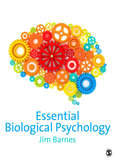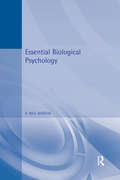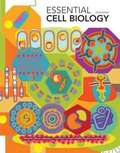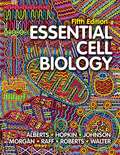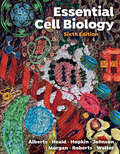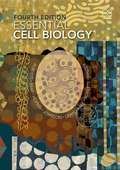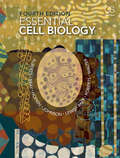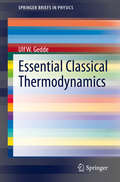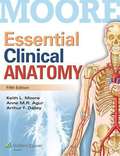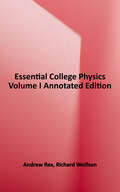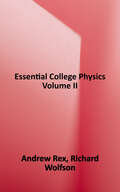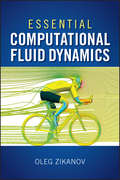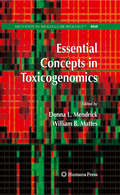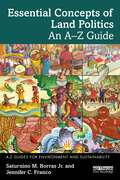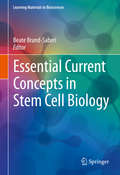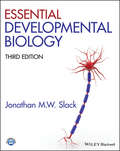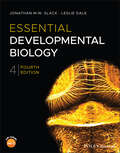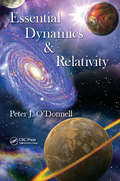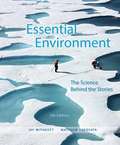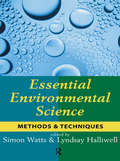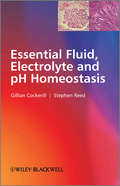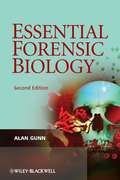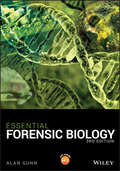- Table View
- List View
Essential Biological Psychology
by Jim BarnesDrawing on the latest exciting research, Essential Biological Psychology provides students with a solid grasp of the relationship between mind and behaviour, and a detailed understanding of the underlying structure and physiological mechanisms that underpin it. The functions of the nervous system are explained and implications for health are explored. Throughout the book, Jim Barnes encourages students to evaluate essential concepts and theoretical issues. <P><P> Features include:<P> * key concepts highlighted throughout the text enables students to grasp the fundamental knowledge and understanding of the structures and functions of the human nervous system that are relevant to the study of psychology <P> * the snapshot of key studies detailed in the textboxes allow critical evaluation of the role of physiology in human behaviour against a backdrop of up to date research <P> * clear explanations of the key methods in the text give students an appreciation of the contributions made by the different approaches and research methods that are used in biological psychology <P> * memory maps and diagrams within the text encourage learning and allow students to formulate memory aids to assist recall in exam conditions <P> * a companion website found at www.sagepub.co.uk/barnes consists of PowerPoint lecture slides and a testbank for teachers (50 questions per chapter) as well as interactive self-assessment testbank for students (10 questions per chapter)
Essential Biological Psychology (Essential Psychology)
by G Neil MartinThe Essential Psychology Series bridges the gap between simple introductory texts aimed at pre-university students and higher level textbooks for upper level undergraduates. Each volume in the series is designed to provide concise yet up-to-date descriptions of the major areas of psychology for first year undergraduates or students taking psychology as a supplement to other courses of study. The authors, who are acknowledged experts in their field, explain the basics carefully and engagingly without the over-simplification often found in introductory textbooks, at the same time providing the reader with insights into current thinking.Essential Biological Psychology is an accessible, well-illustrated and well-written account of the study of the role of the body in behaviour and the effect of behaviour on the working of the body. Covering all the major topics within biopsychology, and evaluating the most up-to-date findings, particularly within neuroscience and neuroimaging research, this textbook is essential reading for first and second level undergraduates taking courses in biological or physiological psychology as well as anyone studying courses in neuropsychology or behavioural neuroscience.
Essential Biomaterials Science
by David WilliamsThis groundbreaking single-authored textbook equips students with everything they need to know to truly understand the hugely topical field of biomaterials science, including essential background on the clinical necessity of biomaterials, relevant concepts in biology and materials science, comprehensive and up-to-date coverage of all existing clinical and experimental biomaterials, and the fundamental principles of biocompatibility. It features extensive case studies interweaved with theory, from a wide range of clinical disciplines, equipping students with a practical understanding of the phenomena and mechanisms of biomaterials performance; a whole chapter dedicated to the biomaterials industry itself, including guidance on regulations, standards and guidelines, litigation, and ethical issues to prepare students for industry; informative glossaries of key terms, engaging end-of-chapter exercises and up-to-date lists of recommended reading. Drawing on the author's forty years' experience in biomaterials, this is an indispensable resource for students studying these lifesaving technological advances.
Essential Cell Biology
by Keith Roberts Dennis Bray Alexander Johnson Julian Lewis Martin Raff Peter Walter Bruce Alberts Karen HopkinEssential Cell Biology provides an accessible introduction to the fundamental concepts of cell biology. Its lively writing and exceptional illustrations make it the ideal textbook for a first course in cell and molecular biology. The text and figures are easy-to-follow, accurate, clear, and engaging for the introductory student. Molecular detail has been kept to a minimum in order to provide the reader with a cohesive, conceptual framework of the basic science that underlies our current understanding of biology. The Third Edition is thoroughly updated scientifically, yet maintains the academic level and size of the previous edition. The book is accompanied by a Media DVD-ROM with over 130 animations and videos, all the figures from the book, and a new self-test quizzing feature for students.
Essential Cell Biology
by Keith Roberts David Morgan Alexander Johnson Martin Raff Peter Walter Bruce Alberts Karen HopkinCell biology is taught in classrooms around the world to provide students with a firm conceptual grounding in biology. This text provides basic, core knowledge about how cells work and uses colour images and diagrams to emphasize concepts and aid understanding.
Essential Cell Biology
by Keith Roberts David Morgan Alexander Johnson Peter Walter Bruce Alberts Karen Hopkin Rebecca HealdThe gold standard textbook, thoroughly updated—now with online homework This text features lively, clear writing and exceptional illustrations, making it the ideal textbook for a first course in both cell and molecular biology. Thoroughly revised and updated, the Fifth Edition maintains its focus on the latest cell biology research. For the first time ever, Essential Cell Biology will come with access to Smartwork5, Norton’s innovative online homework platform, creating a more complete learning experience. This purchase offers access to the digital ebook only.
Essential Cell Biology (Fourth Edition)
by Keith Roberts Dennis Bray Alexander Johnson Julian Lewis Martin Raff Peter Walter Bruce Alberts Karen HopkinThis edition provides introduction to the central concepts of cell biology and covers the latest developments in this fast-moving field.
Essential Cell Biology: Transparency Set
by Keith Roberts Dennis Bray Julian Lewis Martin Raff Peter Walter Bruce Alberts Karen Hopkin Alexander D JohnsonEssential Cell Biology provides a readily accessible introduction to the central concepts of cell biology, and its lively, clear writing and exceptional illustrations make it the ideal textbook for a first course in both cell and molecular biology. The text and figures are easy-to-follow, accurate, clear, and engaging for the introductory student. Molecular detail has been kept to a minimum in order to provide the reader with a cohesive conceptual framework for the basic science that underlies our current understanding of all of biology, including the biomedical sciences. The Fourth Edition has been thoroughly revised, and covers the latest developments in this fast-moving field, yet retains the academic level and length of the previous edition. The book is accompanied by a rich package of online student and instructor resources, including over 130 narrated movies, an expanded and updated Question Bank. Essential Cell Biology, Fourth Edition is additionally supported by the Garland Science Learning System. This homework platform is designed to evaluate and improve student performance and allows instructors to select assignments on specific topics and review the performance of the entire class, as well as individual students, via the instructor dashboard. Students receive immediate feedback on their mastery of the topics, and will be better prepared for lectures and classroom discussions. The user-friendly system provides a convenient way to engage students while assessing progress. Performance data can be used to tailor classroom discussion, activities, and lectures to address students’ needs precisely and efficiently. For more information and sample material, visit http://garlandscience.rocketmix.com/.
Essential Cell Biology: Transparency Set
by Keith Roberts Dennis Bray Julian Lewis Martin Raff Peter Walter Bruce Alberts Karen Hopkin Alexander D JohnsonEssential Cell Biology provides a readily accessible introduction to the central concepts of cell biology, and its lively, clear writing and exceptional illustrations make it the ideal textbook for a first course in both cell and molecular biology. The text and figures are easy-to-follow, accurate, clear, and engaging for the introductory student. Molecular detail has been kept to a minimum in order to provide the reader with a cohesive conceptual framework for the basic science that underlies our current understanding of all of biology, including the biomedical sciences. The Fourth Edition has been thoroughly revised, and covers the latest developments in this fast-moving field, yet retains the academic level and length of the previous edition. The book is accompanied by a rich package of online student and instructor resources, including over 130 narrated movies, an expanded and updated Question Bank. Essential Cell Biology, Fourth Edition is additionally supported by the Garland Science Learning System. This homework platform is designed to evaluate and improve student performance and allows instructors to select assignments on specific topics and review the performance of the entire class, as well as individual students, via the instructor dashboard. Students receive immediate feedback on their mastery of the topics, and will be better prepared for lectures and classroom discussions. The user-friendly system provides a convenient way to engage students while assessing progress. Performance data can be used to tailor classroom discussion, activities, and lectures to address students’ needs precisely and efficiently. For more information and sample material, visit http://garlandscience.rocketmix.com/.
Essential Classical Thermodynamics (SpringerBriefs in Physics)
by Ulf W. GeddeThis book is a concise, readable, yet authoritative primer of basic classic thermodynamics. Many students have difficulty with thermodynamics, and find at some stage of their careers in academia or industry that they have forgotten what they learned, or never really understood these fundamental physical laws. As the title of the book suggests, the author has distilled the subject down to its essentials, using many simple and clear illustrations, instructive examples, and key equations and simple derivations to elucidate concepts. Based on many years of teaching experience at the undergraduate and graduate levels, “Essential Classical Thermodynamics” is intended to provide a positive learning experience, and to empower the reader to explore the many possibilities for applying thermodynamics in other fields of science, engineering, and even economics where energy plays a central role. Thermodynamics is fun when you understand it!
Essential Clinical Anatomy
by Keith L. Moore Anne M. R. Agur Arthur F. Dalley"Get a practical perspective on gross anatomy that will help you understand the importance of anatomic structure and function. Based on the best-selling gross anatomy text, Clinically Oriented Anatomy, Keith Moore's Essential Clinical Anatomy features a succint, well-organized presentation of gross anatomy; boxed clinical information in every chapter; more than 400 full-color images illustrating arteries, nerves, veins, and muscles; 130 comprehensive tables; and surface anatomy highlighted in boxes throughout the text."--BOOK JACKET.Title Summary field provided by Blackwell North America, Inc. All Rights Reserved
Essential College Physics Volume I
by Richard Wolfson Andrew RexThis book provides students with an approachable and innovative introduction to key concepts in physics. Throughout the text, students enjoy clear and concise explanations, relevant real-world examples, and problems that help them master physics fundamentals. <p><p>Following the introductory Chapter 1, the remainder of Volume I is devoted to the mechanics of particles and systems. It includes separate chapters on gravitation, fluids, and waves, including sound. The text concludes with a three-chapter sequence on thermodynamics. Each chapter features annotated figures and detailed problem-solving strategies to help students learn and retain the material with confidence. <p><p>The second edition includes a new four-color format, with color coding of pedagogical features to call greater attention to each. Additionally, new applications have been added to make select topics more current and engaging, both throughout the text and, when possible, within problem sets. <p><p>Essential College Physics Volume I is part of a two-volume set. It can be used independently or in tandem with Volume II. When combined, the two texts cover a full-year course in algebra-based physics, divided either into two semesters or three quarters.
Essential College Physics Volume Ii
by Richard Wolfson Andrew RexThis book effectively introduces students to critical concepts in physics in an approachable and innovative way. Throughout the text, students enjoy clear and concise explanations, relevant real-world examples, and problems that help them master physics fundamentals. The text begins with six chapters on electricity and magnetism, culminating with a concluding chapter on electromagnetic waves and relativity. Following this are two chapters on optics - one on geometrical optics and another on wave optics. The final four chapters cover modern physics, including quanta, atoms, nuclei, and elementary particles. Each chapter features annotated figures and detailed problem-solving strategies to help students learn and retain the material with confidence. The second edition includes a new four-color format, with color coding of pedagogical features to call greater attention to each. Additionally, new applications have been added to make select topics more current and engaging, both throughout the text and, when possible, within problem sets. Essential College Physics Volume II is part of a two-volume set. It can be used independently or in tandem with Volume I. When combined, the two texts cover a full-year course in algebra-based physics, divided either into two semesters or three quarters.
Essential Computational Fluid Dynamics
by Oleg ZikanovThis book serves as a complete and self-contained introduction to the principles of Computational Fluid Dynamic (CFD) analysis. It is deliberately short (at approximately 300 pages) and can be used as a text for the first part of the course of applied CFD followed by a software tutorial. The main objectives of this non-traditional format are: 1) To introduce and explain, using simple examples where possible, the principles and methods of CFD analysis and to demystify the `black box' of a CFD software tool, and 2) To provide a basic understanding of how CFD problems are set and which factors affect the success and failure of the analysis. Included in the text are the mathematical and physical foundations of CFD, formulation of CFD problems, basic principles of numerical approximation (grids, consistency, convergence, stability, and order of approximation, etc), methods of discretization with focus on finite difference and finite volume techniques, methods of solution of transient and steady state problems, commonly used numerical methods for heat transfer and fluid flows, plus a brief introduction into turbulence modeling.
Essential Concepts in Toxicogenomics
by Donna L. Mendrick William B. MattesThe field of toxicogenomics has been growing quickly, yet with rapid growth comes the need to periodically reflect on the nature of the field. Essential Concepts in Toxicogenomics collects reviews, opinion pieces and case studies from the leading experts in this dynamic field with a focus on its application to pharmaceuticals. Topics covered include issues that affect the quality of toxicogenomics experiments, statistical approaches to their data analysis, the use of such data to build toxicogenomic models, and the utilization of genomics to identify biomarkers within the preclinical and clinical arenas. Although not in the standard Methods in Molecular BiologyTM series format, this volume retains the practicality and usefulness of the highly successful series. Informative and cutting-edge, Essential Concepts in Toxicogenomics is an ideal resource for pharmaceutical companies, chemical manufacturers, toxicologists, and all who must keep up-to-date on progress in this vital and important field.
Essential Concepts of Land Politics: An A–Z Guide (A-Z Guides for Environment and Sustainability)
by Saturnino M. Borras Jr. Jennifer C. FrancoThis book compiles, discusses, and explains the key concepts in land politics in an easy-to-navigate A–Z format.This book takes a broad view on land, across the rural and urban corridor, and advocates for a holistic view of the politics of land, as an aggregation of land and global social life, that is, the politics of food, climate, labour, citizenship, and geopolitics. The authors have curated a wide-ranging list of 67 key terms most commonly used in the field, with each entry mapping out an important concept or idea and illustrating how it relates more broadly across this growing discipline. Across the entries, the book showcases that land has been and remains central to productive and social reproductive activities of humanity for the incessant renewal of life and society. A key assumption in this book is that the politics of land is made up of building blocks in the form of key concepts. These key concepts evolve, both in the sense that they are politically contested and in the changing broader context within which they are embedded. The key concepts in this book are therefore not discussed in a random way but rather framed from Critical Agrarian Studies perspectives and scholar-activist tradition, which means taking the side of the exploited and oppressed.With further reading recommendations included alongside the entries, this innovative and accessible volume will be of great interest to students, scholars, policy practitioners, and political activists.
Essential Current Concepts in Stem Cell Biology (Learning Materials in Biosciences)
by Beate Brand-SaberiThis textbook describes the biology of different adult stem cell types and outlines the current level of knowledge in the field. It clearly explains the basics of hematopoietic, mesenchymal and cord blood stem cells and also covers induced pluripotent stem cells. Further, it includes a chapter on ethical aspects of human stem cell research, which promotes critical thinking and responsible handling of the material.Based on the international masters program Molecular and Developmental Stem Cell Biology taught at Ruhr-University Bochum and Tongji University Shanghai, the book is a valuable source for postdocs and researchers working with stems cells and also offers essential insights for physicians and dentists wishing to expand their knowledge.This textbook is a valuable complement to Concepts and Applications of Stem Cell Biology, also published in the Learning Materials in Biosciences textbook series.
Essential Developmental Biology
by Jonathan M. SlackEssential Developmental Biology is a comprehensive, richly illustrated introduction to all aspects of developmental biology. Written in a clear and accessible style, the third edition of this popular textbook has been expanded and updatedIn addition, an accompanying website - www.essentialdevelopmentalbiology.com- provides instructional materials for both student and lecturer use, including animated developmental processes, a photo gallery of selected model organisms, and all artwork in downloadable format.With an emphasis throughout on the evidence underpinning the main conclusions, this book is an essential text for both introductory and more advanced courses in developmental biology.Shortlisted for the Society of Biology Book Awards 2013 in the Undergraduate Textbook category.Reviews of the Second Edition:"The second edition is a must have for anyone interested in development biology. New findings in hot fields such as stem cells, regeneration, and aging should make it attractive to a wide readership. Overall, the book is concise, well structured, and illustrated. I can highly recommend it."--Peter Gruss, Max Planck Society"I have always found Jonathan Slack's writing thoughtful, provocative, and engaging, and simply fun to read. This effort is no exception. Every student of developmental biology should experience his holistic yet analytical view of the subject."--Margaret Saha, College of William & Mary
Essential Developmental Biology
by Jonathan M. Slack Leslie DaleESSENTIAL DEVELOPMENTAL BIOLOGY Discover the foundations of developmental biology with this up to date and focused resource from two leading experts The newly revised Fourth Edition of Essential Developmental Biology delivers the fundamentals of the developmental biology of animals. Designed as a core text for undergraduate students in their first to fourth years, as well as graduate students in their first year, the book is suited to both biologically based and medically oriented courses. The distinguished authors presume no prior knowledge of development, animal structure, or histology. The new edition incorporates modern single cell transcriptome sequencing and CRISPR/Cas9, as well as other methods for targeted genetic manipulation. The existing material has also been reorganized to provide for easier reading and learning for students. The book avoids discussions of history and experimental priority and emphasizes instead the modern advances in developmental biology. The authors have kept the text short and focused on the areas truly central to developmental biology. Readers will benefit from the inclusion of such topics as: A thorough discussion of the groundwork of developmental biology, including developmental genetics, cell signaling and commitment, and cell and molecular biology techniques An exploration of major model organisms, including Xenopus, the zebrafish, the chick, the mouse, the human, Drosophila, and Caenorhabditis elegans A treatment of organogenesis, including postnatal development, and the development of the nervous system, mesodermal organs, endodermal organs, and imaginal discs in drosophila A final section on growth, stem cell biology, evolution, and regeneration Perfect for undergraduate students, especially those preparing to enter teaching or graduate studies in developmental biology, Essential Developmental Biology will also earn a place in the libraries of those in the pharmaceutical industry expected to be able to evaluate assays based on developmental systems.
Essential Dynamics and Relativity
by Peter J. O'DonnellEssential Dynamics & Relativity provides students with an introduction to the core aspects of dynamics and special relativity. The author reiterates important ideas and terms throughout and covers concepts that are often missing from other textbooks at this level. He also places each topic within the wider constructs of the theory, without jump
Essential Environment: The Science Behind The Stories 5th Ed
by Jay Withgott Matthew LaposataEssential Environment: The Science behind the Stories, Fifth Edition engages students using current, integrated case studies that provide a context for understanding science and environmental concerns in a brief, 18-chapter text. Jay Withgott and Matt Laposata present the latest understanding of environmental science along with expanded FAQ discussions that address common student misconceptions and with new Data Analysis questions that build quantitative literacy.
Essential Environmental Science: Methods and Techniques
by Simon Watts Lyndsay HalliwellEssential Environmental Science brings together within a single volume the vast range of techniques, methods and basic tools necessary for the study of the environment. Environmental science has a massive area of operation, utilising the tools from a plethora of traditional sciences and social sciences. This practical manual draws on contributions from leading experts in each field, to present both general and specific environmental methods and techniques within a unique interdisciplinary environmental perspective.Essential Environmental Science offers an invaluable reference source for environmental study in both the laboratory and in the field.
Essential Fluid, Electrolyte and pH Homeostasis
by Stephen Reed Gillian CockerillThis textbook provides a unique, pocket-sized, self-directed study guide to fluid, electrolyte and acid base homeostasis for undergraduate biomedical science, pharmacology, medical and allied health students. It details the chemical (mostly ionic) composition of body fluids, explains how abnormalities arise, what laboratory tests can be used to identify and analyze the cause of these disorders and shows how normality can be achieved to maintain health.
Essential Forensic Biology
by Alan GunnThis book is an introduction to the application of biology in legal investigations. Fully revised and updated throughout, the second edition of this highly successful textbook offers an accessible overview to the essentials of the subject providing a balanced coverage of the range of organisms used as evidence in forensic investigations; invertebrates, vertebrates, plants and microbes.The book provides an overview of the decay process and discusses the role of forensic indicators - human fluids and tissues, including blood cells, bloodstain pattern analysis, hair, teeth, bones, and wounds. It also examines the study of forensic biology in cases of suspicious death.The coverage of molecular techniques has been expanded throughout with additional material on bioterrorism and wildlife forensics now included. The use of DNA and RNA for the identification of individuals and their personal characteristics is now covered along with a discussion of the ethical issues associated with the maintenance of DNA databases.* Fully revised and updated new edition of this highly successful textbook.* Includes self-assessment questions at the end of each chapter and case studies.* Now in full colour throughout.* Includes a supplementary website (www.wileyeurope.com/college/gunn) covering additional material and self-test questions to reinforce student understanding.From the reviews of the first edition:"The author does an excellent job of demonstrating how biological science can, and does, contribute to legal investigations..." THE QUARTERLY REVIEW OF BIOLOGY"...a super book ...not a book that will languish on library shelves. Buy it!" JOURNAL OF BIOLOGICAL EDUCATION"...naturalists and biologists will find much of interest within these books...new light on the application of their own specialism..." THE NATURALIST"Overall, I give it my highest recommendation. I was unable to find a single paragraph that was no fascinating, despite being sad or gruesome at times." E-STREAMS
Essential Forensic Biology: Animals, Plants And Microorganisms In Legal Investigation
by Alan GunnA completely revised and updated edition that teaches the essentials of forensic biology, with increased coverage of molecular biological techniques and new information on wildlife forensics, wound analysis and the potential of microbiomes as forensic indicators This fully revised and updated introduction to forensic biology carefully guides the reader through the science of biology in legal investigations. Full-colour throughout, including many new images, it offers an accessible overview to the essentials of the subject, providing balanced coverage of the range of organisms used as evidence in forensic investigations, such as invertebrates, vertebrates, plants and microbes. The book provides an accessible overview of the decay process and discusses the role of forensic indicators like human fluids and tissues, including bloodstain pattern analysis, hair, teeth, bones and wounds. It also examines the study of forensic biology in cases of suspicious death. This third edition of Essential Forensic Biology expands its coverage of molecular techniques throughout, offering additional material on bioterrorism and wildlife forensics. The new chapter titled ‘Wildlife Forensics’ looks at welfare legislation, CITES and the use of forensic techniques to investigate criminal activity such as wildlife trafficking and dog fighting. The use of DNA and RNA for the identification of individuals and their personal characteristics is now covered as well, along with a discussion of the ethical issues associated with the maintenance of DNA databases. Fully revised and updated third edition of the successful student-friendly introduction to the essentials of Forensic Biology Covers a wide variety of legal investigations such as homicide, suspicious death, neglect, real and fraudulent claims for the sale of goods unfit for purpose, the illegal trade in protected species of plants and animals and bioterrorism Discusses the use of a wide variety of biological material for forensic evidence Supported by a website that includes numerous photographs, interactive MCQs, self-assessment quizzes and a series of questions and topics for further study to enhance student understanding Includes a range of important, key case studies in which the difficulties of evaluating biological evidence are highlighted Essential Forensic Biology, Third Edition is an excellent guide for undergraduates studying forensic science and forensic biology.
